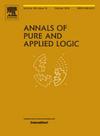不可数同构结构
IF 0.6
2区 数学
Q2 LOGIC
引用次数: 0
摘要
研究了不可数一阶结构的存在性,这些结构对其有限生成的子结构是齐次的。在许多经典情况下,这要么是众所周知的,要么是遵循一般事实的,例如,如果语言是有限的和关系的,那么超能力提供任意大的这样的结构。另一方面,没有一般的结果表明,具有给定年龄的不可数同质结构存在。我们研究了固定可数齐次结构的自嵌入单群,并利用抽象的Fraïssé理论,提出了一种构造不可数齐次结构的方法,该方法基于该单群的合并性质。本文章由计算机程序翻译,如有差异,请以英文原文为准。
Uncountable homogeneous structures
We study the existence of uncountable first-order structures that are homogeneous with respect to their finitely generated substructures. In many classical cases this is either well-known or follows from general facts, for example, if the language is finite and relational then ultrapowers provide arbitrarily large such structures. On the other hand, there are no general results saying that uncountable homogeneous structures with a given age exist. We examine the monoid of self-embeddings of a fixed countable homogeneous structure and, using abstract Fraïssé theory, we present a method of constructing an uncountable homogeneous structure, based on the amalgamation property of this monoid.
求助全文
通过发布文献求助,成功后即可免费获取论文全文。
去求助
来源期刊
CiteScore
1.40
自引率
12.50%
发文量
78
审稿时长
200 days
期刊介绍:
The journal Annals of Pure and Applied Logic publishes high quality papers in all areas of mathematical logic as well as applications of logic in mathematics, in theoretical computer science and in other related disciplines. All submissions to the journal should be mathematically correct, well written (preferably in English)and contain relevant new results that are of significant interest to a substantial number of logicians. The journal also considers submissions that are somewhat too long to be published by other journals while being too short to form a separate memoir provided that they are of particular outstanding quality and broad interest. In addition, Annals of Pure and Applied Logic occasionally publishes special issues of selected papers from well-chosen conferences in pure and applied logic.

 求助内容:
求助内容: 应助结果提醒方式:
应助结果提醒方式:


